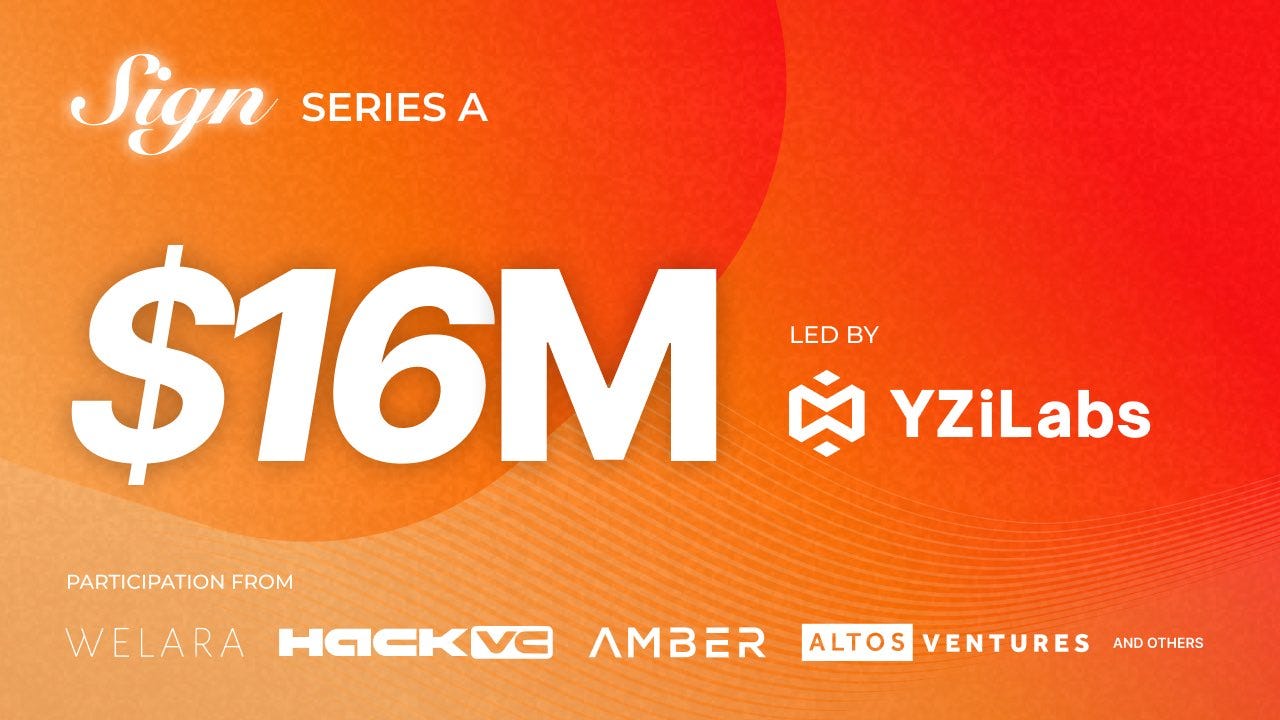Sign: The Trust Engine On Blockchain
In this research, I examine how Sign functions as the definitive trust engine for blockchain, employing innovative strategies to catalyze mainstream crypto adoption
Introduction
As tokens emerge as crypto's most transformative innovation, token distribution and management tools are becoming one of the most critical infrastructures. In this context, TokenTable—Sign's flagship token management platform—has demonstrated remarkable market validation. The platform's meteoric rise is evidenced by its extraordinary growth trajectory, scaling from zero to over $14 million in revenue in under twelve months. In fact, TokenTable is now among the fastest growing products in the space.
The root of this phenomenal success lies in Sign's unique attestation magic. By leveraging attestation on both offchain and onchain data and allowing it to seamlessly compose with onchain stacks, Sign has been able to find its approach to building useful and effective products for Web3 participants and the out-of-crypto audience.
In this report, I will dissect how Sign works under the hood and explore the future opportunities for Sign. Specifically, I will highlight how Sign brings trust to trustless networks and explore its potential impact on driving mainstream crypto adoption.
Building Trust on Trustless Systems
Public blockchains represent a paradigm shift in data management through three core features: transparency, verifiability, and trustlessness. Every transaction is permanently recorded and can be independently verified by any participant. Users can directly interact with networks without relying on centralized intermediaries. These fundamental characteristics create an unprecedented foundation for authentication and verification.
Sign harnesses these blockchain features to construct robust digital identities and establish human trust in the crypto ecosystem. By utilizing omnichain attestation and zero-knowledge proofs, Sign delivers a decentralized, interoperable trust framework that seamlessly connects offchain and onchain data. It empowers the creation of comprehensive user profiles while maintaining blockchain's core principles of transparency and verification.
The convergence of blockchain's trustless architecture with Sign's trust-building mechanisms opens new possibilities for crypto adoption. With the integration of human trust networks into blockchain systems, Sign unlocks a number of new applications ranging from targeted retroactive airdrops to credit-based lending and onchain KYC/AML for addresses.
Given the aforementioned, it seems pertinent timing to explore how Sign is taking a fundamentally novel approach to fostering onchain trust and crypto mainstream adoption with its magic.
The Sign Ecosystem
Bigbrains behind Sign
Behind Sign stands a formidable team of blockchain innovators. Founded in 2021, Sign has been developed by an elite group of 20+ big brains. Co-Founder and CEO XinYan brings seasoned entrepreneurial leadership and extensive Web3 expertise, built through years of crypto mining and investment experience. Fellow Co-Founders Jack and Potter are close friends of XinYan, and have demonstrated deep knowledge of blockchain architecture, smart contracts, and software engineering.
The Sign team maintains a strong technical focus, with developers and engineers comprising more than half of its workforce. The development-centric style has driven high productivity and innovation all along. In terms of fundraising, Sign has secured a total of $30 million from leading venture capital firms and investors, including YZi Labs, Sequoia Capital, and Balaji.
EthSign
EthSign is an onchain "docusign" with cryptographic security and user-friendly signing processes. It enables users to sign, manage, and verify electronic agreements (contracts, protocols, etc.) on blockchains in a decentralized, transparent, and secure manner.
Being the first product of Sign ecosystem, EthSign is equipped with a number of cool features that allow users to sign documents flexibly, including:
Digital signatures on EthSign are generated with EIP-712 or equivalent standards and written into the documents.
Ethsign supports keyless encryption, where users never have to remember any document passwords again. Once users enable advanced encryption for their addresses, they can even retrospect past documents.
Mainstream nations’ digital signature laws and signatures are compiled within EthSign and can be verified publicly at zero cost.
Multiple wallets from multiple blockchains interacting with each other are supported on EthSign
Significantly, EthSign adopts the practice of decentralized settlement. All settled contracts or documents are automatically submitted to Arweave at no cost to end users, while users can still access their signed documents and cryptographic proof-of-consent independently. As of now, over 2 million users worldwide are leveraging EthSign to sign electronic agreements at minimal cost.
Sign Protocol
Drawing inspiration from EthSign, Sign Protocol emerges as an omnichain attestation protocol, empowering users to freely attest and verify any information onchain. It allows individuals to create attestations—digitally signed assertions—through predefined schemas that guarantee data uniformity and integrity.
Put it simply, Sign Protocol is structured as follows:
Schemas: Templates defining data format for attestations, ensuring clarity and verifiability.
Attestations: Signed data following a schema, stored securely on- or off-chain.
Schema Hooks: Custom Solidity code executed during attestation creation or revocation, adding logic like payments or whitelists.
Indexing Service: Enhances searchability and retrieval of attestations.
On Sign Protocol, users can encode data per a schema, sign it digitally, and store the attestation. Schema hooks allow customization, such as restricting access or triggering actions. The indexing service makes attestations readily accessible. To date, Sign Protocol hosts 163,608 schemas and 3,826,628 attestations across 18 blockchains.
By embracing multichain compatibility, Sign Protocol simplifies the traditionally intricate notarization process, striving for an intuitive experience akin to a Google search. It enhances trust in applications like credit scoring and reputation systems by delivering verifiable, adaptable data across diverse blockchains.
TokenTable
TokenTable is a suite of onchain token distribution products designed to streamline token ownership registration and distribution through smart contracts.
Currently, it offers three mini products:
Airdrop Pro: For large-scale token distributions across networks like Ethereum, TON, and Solana.
Airdrop Lite: A streamlined option for smaller distributions, primarily on TON.
Unlocker: For customized token unlocking schedules, supporting cliffs, linear vesting, and discrete releases.
TokenTable is the all-in-one platform to manage token operations. It uses merkle trees for cost-effective distributions for token airdrops. While in Unlocker, users deposit tokens into contracts and define unlocking schedules, allowing recipients to claim tokens as scheduled. Users can also deploy their own instances, manage deposits and withdrawals flexibly, and integrate with EthSign for legally binding onchain signatures and fund transfers.
TokenTable stands out as the flagship product within the Sign ecosystem, reigning as the largest token distribution platform in the blockchain landscape. It has facilitated a staggering $4 billion in token airdrops and unlocks, earning the trust of over 200 projects, including Movement, Starknet, ZetaChain, DOGS, Mocaverse, Berachain, and Kaito. To date, TokenTable has empowered 40 million users and investors with seamless access to their distributions.
Remarkably, TokenTable ranks among the most lucrative products in the industry, generating over $14 million in revenue in 2024 alone. As Sign Daddy XinYan revealed in a community space that, given its current growth trajectory, TokenTable is poised to achieve an impressive $30 million in revenue by 2025.
SignPass and Others
SignPass is a pioneering digital identity infrastructure that seamlessly connects global citizens and communities. At its core, Sign Protocol enables the creation of blockchain-based, verifiable identities that integrate smoothly with existing passport systems, effectively bridging traditional and digital identity verification methods. By establishing a new framework for citizenship and residency in the increasingly connected world, SignPass is working to harmonize emerging "Network States" with traditional nation-states.
The platform has already achieved significant milestones in government collaboration. In partnership with Sierra Leone, SignPass has launched the world's first blockchain-based digital Permanent Residency (PR) program. It has also forged a strategic alliance with Ras Al Khaimah to develop a Web3 Entrepreneur Program, simplifying the application process for the UAE's prestigious golden visa. According to CEO XinYan, the Sign team is actively engaging with additional governments to expand SignPass adoption globally.
Beyond digital identity solutions, the Sign team is developing innovative products to enhance everyday life of global citizens. These include:
Sign App, linking real-world IDs to blockchain wallets in a user-friendly way.
SignCard (currently in beta testing), offering seamless global payments with integrated cryptocurrency on/off-ramp capabilities.
Global eSIM service (launching soon), providing borderless connectivity.
The Opportunities for Sign
So, what is Sign and what else can we do with Sign?
Sign represents a long-term commitment to push the boundaries of transformative innovation across the Web3 ecosystem and beyond. By connecting real-world credentials to blockchains, Sign is building a suite of fundamental infrastructure for transparency and trust. As XinYan articulates,
"We’ve nailed how to distribute tokens. Now, we’re focusing on who to distribute tokens to. Blockchain is evolving into a global offshore financial hub, and our mission is to make it safer and more trusted."
Rather than competing for existing crypto users, Sign aims to expand the ecosystem by onboarding new participants and building a trusted digital realm. To achieve the goal, various strategic approaches are adopted: from effective token distribution methods for new users to establishing partnerships with governments and real-world entities.
Now that we have a nuanced understanding of Sign on a more granular level, let’s zoom out and explore broader opportunities of Sign.
RWA Tokenization and Distribution
Real-World Asset (RWA) tokenization and distribution stands out as a key opportunity. When physical or financial assets—such as real estate, art, or commodities—are converted into digital tokens on blockchains, TokenTable simplifies token management through smart contracts and automates the distribution and unlocking processes. In the meantime, integration with EthSign ensures legally binding onchain signatures, addressing RWA compliance needs. EthSign's robust data privacy framework also ensures the secure management of valuable tokenized assets, addressing one of the primary concerns in the RWA sector.
In-depth Collaboration with Governments
While many crypto startups maintain a cautious distance from regulatory oversight, Sign takes a distinctly different approach. The crypto industry has historically suffered from limited direct engagement with governmental authorities, creating a gap in mutual understanding and collaboration.
Sign bridges this divide by aligning its vision with governments' digital transformation initiatives. It leverages blockchain technology to advance public sector innovation. The strategic alignment with governmental priorities positions Sign uniquely in the market. More significantly, such top-down adoption of cryptocurrency infrastructure through official channels has the potential to catalyze unprecedented mass adoption.
Capabilities in the AI Sector
Identity verification stands at the forefront of AI industry challenges, particularly in critical areas such as data provenance, access control, and accountability. Sign is able to address these fundamental needs by providing a robust identity verification infrastructure that ensures only authenticated entities—whether human users or AI agents—can access and interact with sensitive AI tools, models, and datasets.
Besides, Sign's attestation framework can offer a breakthrough solution for AI developers, enabling them to validate that training and inference data comes from verified, trusted sources and remains tamper-proof throughout its lifecycle.
Consequently, Sign emerges as an underappreciated but pivotal force in the AI industry. Its comprehensive identity and verification infrastructure lays the groundwork for developing more transparent, trustworthy, and responsible AI solutions.
The Sign Community
Sign is more than an ecosystem or brand. At its core, it's a thriving community-driven movement.
Orange Dynasty
The Orange Dynasty, Sign's official community, exemplifies Sign's spirit through its emphasis on authentic connection, mutual support, and collaborative building. Initiated by the Sign intern, Orange Dynasty aims to be a safe space where members can rediscover the joy of genuine online interaction. The community's identity is distinctively represented through the color orange and its emblematic symbols: the orange heart (🧡) and dragon (🐉), which have become rallying points for members.
Recently, the Sign intern has drafted OrangePrint, a comprehensive guide to Sign's community and how to participate. Check here if you’re interested.

Orange Dynasty is a growth hack of community building. In less than five months, it turned into a harbour for over 27,000 (real!!!) people. The growth of Orange Dynasty stands as a testament to how digital communities can foster meaningful human connections and community engagement through memetic cultures.
SBT (Sign-Bound Tokens)
Soul-Bound Tokens, (aka Sign-Bound Tokens, SBT) are non-transferable badges of honor to represent outstanding contributions to the Orange Dynasty. There are 4 types of SBTs, including:
Outstanding Content Creation: For those who are consistently making an effort to explore and improve their craft in content creation, not limited to any format or style.
Serious Builders: For those who go way above and beyond in their own way.
Orange in the Veins: For those who actively participate in community events, attend twitterspaces, and are active in the telegram group chat.
Support Warrior: For those who show avid support to fellow Orange Dynasty members in supporting and giving genuine feedback to their posts and participating in Sign’s post activities on X.
All the SBTs will be distributed to community members in multiple rounds. The SBT distribution mechanism is carefully designed to maximally ensure everyone has an equal chance at every round, regardless of time of entry.
With a capped supply of no more than 460, SBTs are one of the rarest assets within the Sign ecosystem. Currently, the Round 1 SBT distribution has concluded, rewarding approximately 230 community builders. Subsequent batches will decrease by half with each release.
Seeing Signs NFTs
Unlike SBT reserved for dedicated community builders, Sign also offers 1807 Seeing Signs NFTs for those who share aligned mission and vision. These NFTs will have the same functions as the SBTs, making them equally valuable within the ecosystem. The Seeing Signs NFTs were sold out in 23 minutes during the initial mint, but it is still available in secondary markets such as OpenSea and Blur. It's interesting to note that Sign teams do not have a pre-allocation and have to repurchase NFTs from the secondary market to reward loyal supporters.
$SIGN Token
Sign is gearing up for a token launch in the near future, signaling an exciting milestone for its community. Though the specifics of $SIGN tokenomics are yet to be unveiled, Sign has proactively amassed a $10 million Bitcoin treasury reserve to bolster the token’s adoption. Moreover, future profits from the Sign ecosystem will fuel $SIGN buybacks, which reinforces the token's long-term value.
Looking Ahead
Coming off the back of arguably the most well-executed business expansion and community building in the crypto space, Sign is now a formidable market contender with 40 million addresses served. With the market’s unrelenting hunger for token generation showing no signs of slowing, Sign’s path to reaching 1 billion addresses feels increasingly within reach.
Beyond the current scale, Sign’s moat seem to be expanding. Through offerings like EthSign, Sign Protocol, TokenTable, SignPass, and SignCard, Sign leverages attestation technology and integrates real-world utilities to establish a robust and thriving ecosystem. As a result, Sign remains defensible as one of the pioneers to bridge trust between the physical and digital world.
Looking ahead, Sign is way more than what it is now. In the coming months, Sign will release several groundbreaking products (stay tuned...s) that promise to dismantle the silos of identity and trust. Strategically, Sign is poised to deepen its impact by bridging opportunities in real-world assets (RWA), government partnerships, and AI-driven data verification, all while staying true to its core mission of making crypto useful and engaging. Let's wait and witness how its influence takes shape.












